Video: https://youtu.be/zoojbnEdSVc
Title: Hybrid City
Site: Overhead Bridge
Credits: Directed and narrated by Kwan Yin Kiu
Storyboard & Script
Scene 1: Intro

Scene 2: Theme
Shot: Wai Yip Street Footbridge

Transcript: “The fate of the bridges is to be lonely; because bridges are to cross not to stay.” -Mehmet Murat Ildan
Scene 3: Theme


Transcript: Professor Mee Kam Ng, Director of the Urban Studies Programme at CUHK, once said, “Majority of bridges in Hong Kong are merely functional, just like conveyor belts, as people cross them in a hustle, wanting to reach the other end faster”
Scene 4
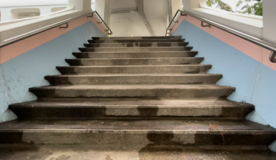
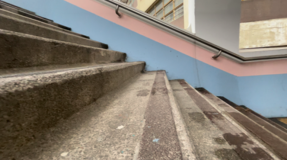
Transcript: In the book ”Cities without Ground”, Hong Kong is described as a city without ground. Road surface is a continuous plane and stable reference point for cultural life, yet in Hong Kong, pedestrians are forced up to the bridges or down to the tunnels while the road surface is reserved for the vehicles[1].
Should our city continue building bridges and abandon the ground?
Scene 5: Appearance of overhead bridges in HK
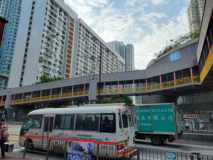
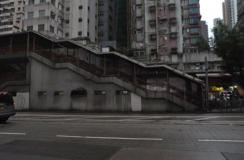


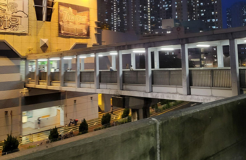
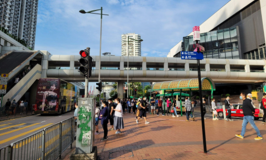
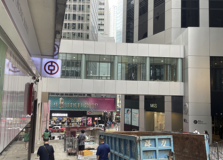
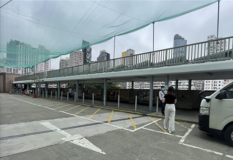
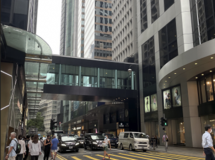
Scene 6: Appearance of overhead bridges in HK
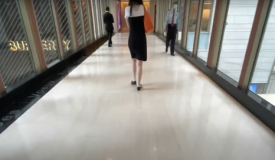
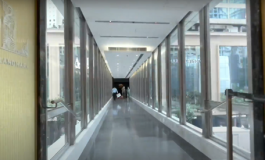
Transcript: The appearance of bridges all started as a network for developers, signifying the prosperity of Hong Kong. 1960s was a turning point for Hong Kong’s economy. As its manufacturing capabilities surges, bridges were built to separate pedestrian and vehicles to different layers hence increase speed and traffic volume of roads.
Central Elevated Walkway is a complex and extensive air-conditioned overhead bridge system which connects financial centres and skyscrapers in this central business district, proving its significant commercial value in this multilayered city.
Scene 7: Disappearance of old bridges no longer in use
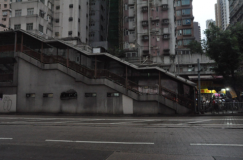
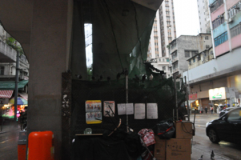
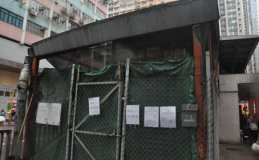


Photo source: The Standard[2] Photo source: Dimsum Daily[3]
Transcript: Yet, “the way the city has been made to appear in many representations in fact works to make it disappear” -Building on Disappearance, Abbas, M. A.
On the other side of HK, some bridges are on the verge of disappearance as they lose their historical significance and are out of place in the environment. Tong Shui Road footbridge in North Point was once used by residents to cross King’s Road. Yet with construction of road facilities, the bridge has then been rarely used, hence became a house for the homeless, wild pigeons and abandoned items. After a fire in 2020, the Transport Department closed the bridge, surrounded it with a barbed wire and proposed that it would be best to tear down the structure. As they completed their historical duty, disappearance of bridges, despite them once being representation of the Hong Kong’s development, seems to be inevitable as the city progresses.
Scene 8: Meaning of bridge and the space it creates
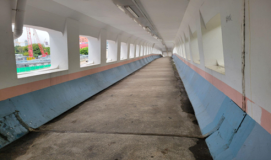
Transcript: So, are bridges destined to be lonely? I would say that the meaning of bridges lies within the space it creates. Bridges should be viewed as an architecture itself- their appearance and disappearance, all were significant to the city’s development and its people. Bridges for the prosperity and bridges for the poor, both have their significance in HK as a hybrid city. Hence, bridges are not merely a place for passageway, but are encoded into citizen’s lifestyles, or even shelter to the homeless and space for gathering of domestic workers. With careful city planning taking into account the people’s needs, bridges could be something more than just a routine or activity without experience.
Scene 9: Outro

Video Essay
Theme and subject matter
Hong Kong, a global city that positioned itself to become the world city of Asia, is much well known as an international metropolis by adopting a high density compact city development model. Yet, the city does not only develop vertically with towering skyscrapers, but also horizontally through an extensive network of overhead bridges.
The video is based on a quote from Turkish poet and playwright Mehmet Murat Ildan: “The fate of the bridges is to be lonely; because bridges are to cross not to stay.” Hence bring out the question: should our city continue building bridges and abandon the ground?
Just like any other infrastructures, construction and destruction of overhead bridges were influenced by socioeconomic and cultural background of the city. Appearance of bridges originated with Hong Kong’s economic surge. Central Elevated Walkway as a representative, is described as a “tentacular circulatory system” to achieve networked urbanism, as Jardine House and the extension of the public plaza vis-à-vis the elevated walkways to connect with plazas of other buildings effected palpable changes to the form, space and speed of Central District[4]. On the other hand, disappearance of certain bridges that are no longer in use, with Tong Shui Road footbridge as an example, is also part of the city’s developement, despite erasing its existence which bore functional value at some time in the past.
This video will unveil the meaning of overhead bridges.
Method of conducting the research
Method of conducting the research consists of collecting first hand information- from site visit to bridges in Hong Kong; and second hand information- online resources and reading materials from course content.
The outline of my research process was to investigate into different scholars’ point of view towards the numerous bridges in Hong Kong and Hong Kong as a multilayered city with such extensive network of bridges. I was surprised to learn the polarized opinions on the bridges- some think that Hong Kong lacks any of the traditional figure-ground relationships that shape urban space[5], while others appreciate how mapping the three-dimensional circulation networks prompted development of Hong Kong
Based on such contrasting views on overhead bridges in Hong Kong, I came up with the theme to discuss the two-sidedness of overhead bridges and how they play a role in people’s lives as well as Hong Kong as a whole as a hybrid city.
Producing the video
As I was designing the storyboard for the video, I was concerned about how to include such large amounts of content and description into the 2.5-minute video without compromising both information and cinematography. Another problem was the inability to emphasize the level of extensiveness of overhead bridge systems in Hong Kong, especially with limited filming techniques on the table, so how could I provide a better view of the interconnected city without drone shots? That was when I came up with the idea to film the entire video on first person point of view as a walker- the elementary form of this experience of the city just like the people whom we are used to be- the ordinary practitioners of the city living “down below”[6]. As I narrate the video as if I were bringing the viewers to an actual tour around the bridges the city, viewers could immerse themselves to “experience” the overhead bridges and be personally on the scene.
I also utilized a sped up video as a walkthrough guide of the Central Elevated Walkway using a one-shot take, which amplifies its comprehensiveness as the most extensive multilevel pedestrian system in the world.
Reflections
An interesting point to note is that Hong Kong employs “on-demand planning” to develop and refine the system and respond to changing circumstances, with planners use data-mapping to focus on specific districts rather than trying to achieve a continuous urban network[7]. This explains the dynamic and ever-changing structure of the city, which also prompts the appearance and disappearance of architectures in order to cope with development of the city, reflecting on the significant role that infrastructures like overhead bridges play in a city in process.
One interesting episode that happened when i shoot the video was an unexpected rain when filming the tong shui road bridge, which added a sense of solemn yet sadness of the atmosphere. Every architecture could have its own story if you are willing to look. “Stories thus carry out a layout that constantly transforms places into spaces or spaces into places.” Hence with unique experiences created on the places within the overhead bridges, they could be spaces with significance to the city and its people, for instance the prosperity of Hong Kong displayed throughout the multilayered urbanism in Central Elevated Walkway, as well as Tong Shui Road footbridge as a shelter for the homeless, both turned the ordinary passageway into an architecture with its own unique spatial experience to be experienced by people who pass through.
Bibliography
- Adam Frampton, Jonathan D. Solomon, and Clara Wong (Jan 2013); Cities Without Ground: A Hong Kong Guidebook
- The Standard (Nov 2021); Burnt Tong Shui Road footbridge in North Point to be demolished
- Dimsum Daily (Apr 2020); Fire breaks out at overhead pedestrian footbridge on Tong Shui Road in North Point
- Seng, Eunice (Apr 2020); “Towers.” In: Resistant City : Histories, Maps and the Architecture of Development, 79-94
- Adam Frampton, Jonathan D. Solomon, and Clara Wong (Jan 2013); Cities Without Ground: A Hong Kong Guidebook
- Michel de Certeau (1980); The Practice of Everyday Life
- Yoos, Jennifer, and Vincent James (2016); “The Multilevel Metropolis.” Places (Cambridge, Mass.)
Kwan Yin Kiu 3035934391
Your selected bridges and places inspired me a lot. The comparison of Wai Yip Street Footbridge and Tong Show Road footbridge ignite me to think about the disappearance of the urban characteristics. Overhead bridges, as part of the constituent of this stranded city, when their appearance and their use cannot match with the ever-changing urban city, what should people deal with this architecture? Demolition? Renewal? As your mentioned a quote “The fate of the bridges is to be lonely; because bridges are to cross not to stay.” Similarly, the fate of the bridges are also sorrowful because they are not uncommon as the heritage and conserved it while they also witness the change of a city. Even though their fate is not blessed, they contribute to the prosperity of the city. Thank you producing this meaningful documentary and rendering me a chance to the virtual tour. –Yeung Po Ying
‘You have created a thematically clear and reflective film. I appreciate your elaborate observation of various bridges in Hong Kong, as well as the solid references. However, I would suggest polishing the filming techniques, especially in the one-shot in the film, the image shake is very obvious after speeding up, this might impact the visual effect and watching experience. Besides, please think about how your video can more appropriately correspond to the theme of the hybrid city? It is pitiful that the bridges’ functions mentioned in your essay as shelters for the homeless and entertainment spaces for domestic helpers are not represented in the film.